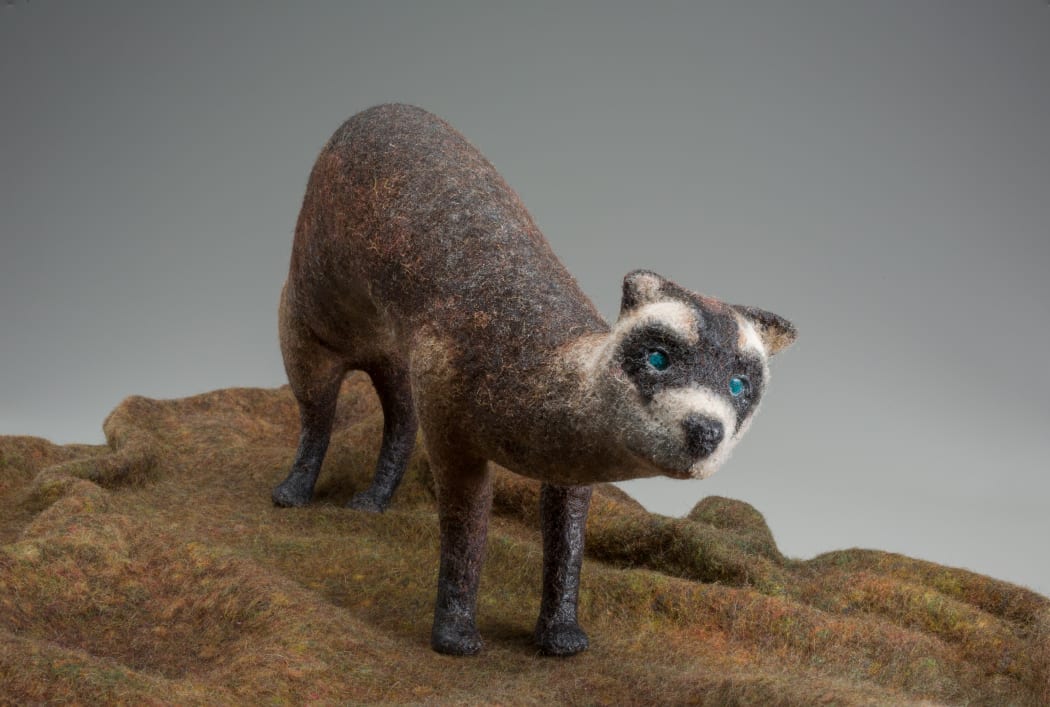
Susan Aaron-Taylor manifests her dreams into reality. Born from years of formal and solo study into Jungian psychology, Aaron-Taylor's meticulously crafted figures, often animals, speak to the artist's lifelong fascination with dreams. The domestic family pet, hand-felted and fitted with seashells, cabochons, polished bone or even porcupine quills, is transformed with latent meaning that vacillates between the deeply personal and the universal. Here, the collective unconscious is under the spell of the strangely familiar, the almost known, and, ultimately, in their beautifully intimate finished forms, the sublime.
In this interview, Susan Aaron-Taylor discusses hard-won revelations of the pandemic era and how they've informed her work. Throughout the conversation, you'll see new artworks (created in lockdown) that are available now at form & concept. View Susan's artist page to browse all of her work.
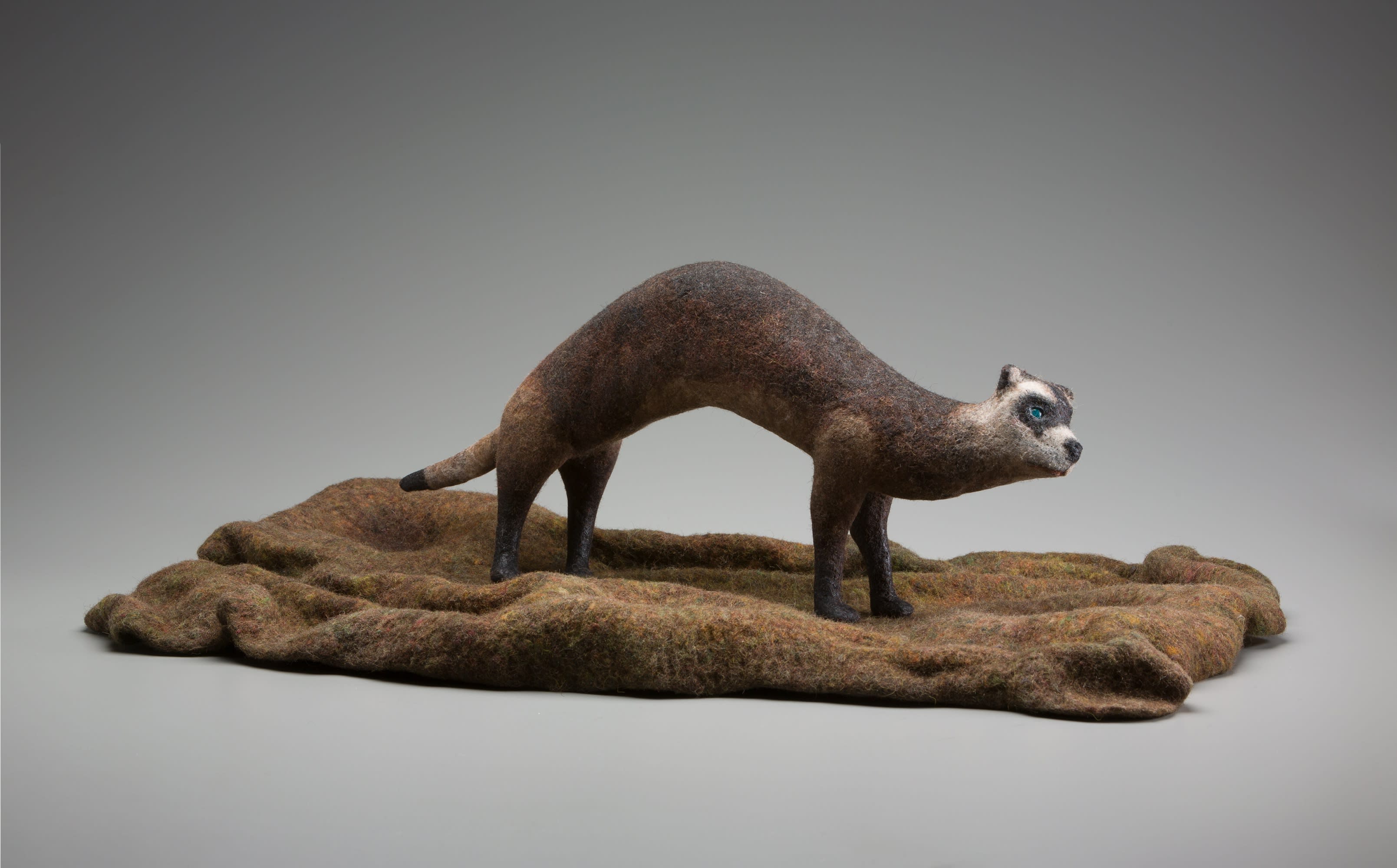
Susan Aaron-Taylor, Black Footed Ferret 2, wood, handmade felt, turquoise cabochons, aragonite.
Give me some pandemic wisdom that you’ve gathered so far.
Susan Aaron-Taylor: We have to be really flexible right now and not hold onto old ways. Everything is changing, so just live in the moment. Don’t look into the future because there’s no point.
Has that philosophy unleashed your creative process?
SAT: At first I was dealing with a lot of fear because we didn’t know anything. It was hard to focus. I would go to my studio every single day, and I could only do things that were more repetitive. There’s a lot of repetitive stuff when you’re working partly with fiber.
Then I got into a really focused kind of place, and the work came really quickly. I finished the African Wild Painted Dog, and then I started working from my dreams. I do that a lot, and I work from shamanic journeys a lot. I started dipping down into those wells. What I found is that everything is being affected by the virus. By fear.
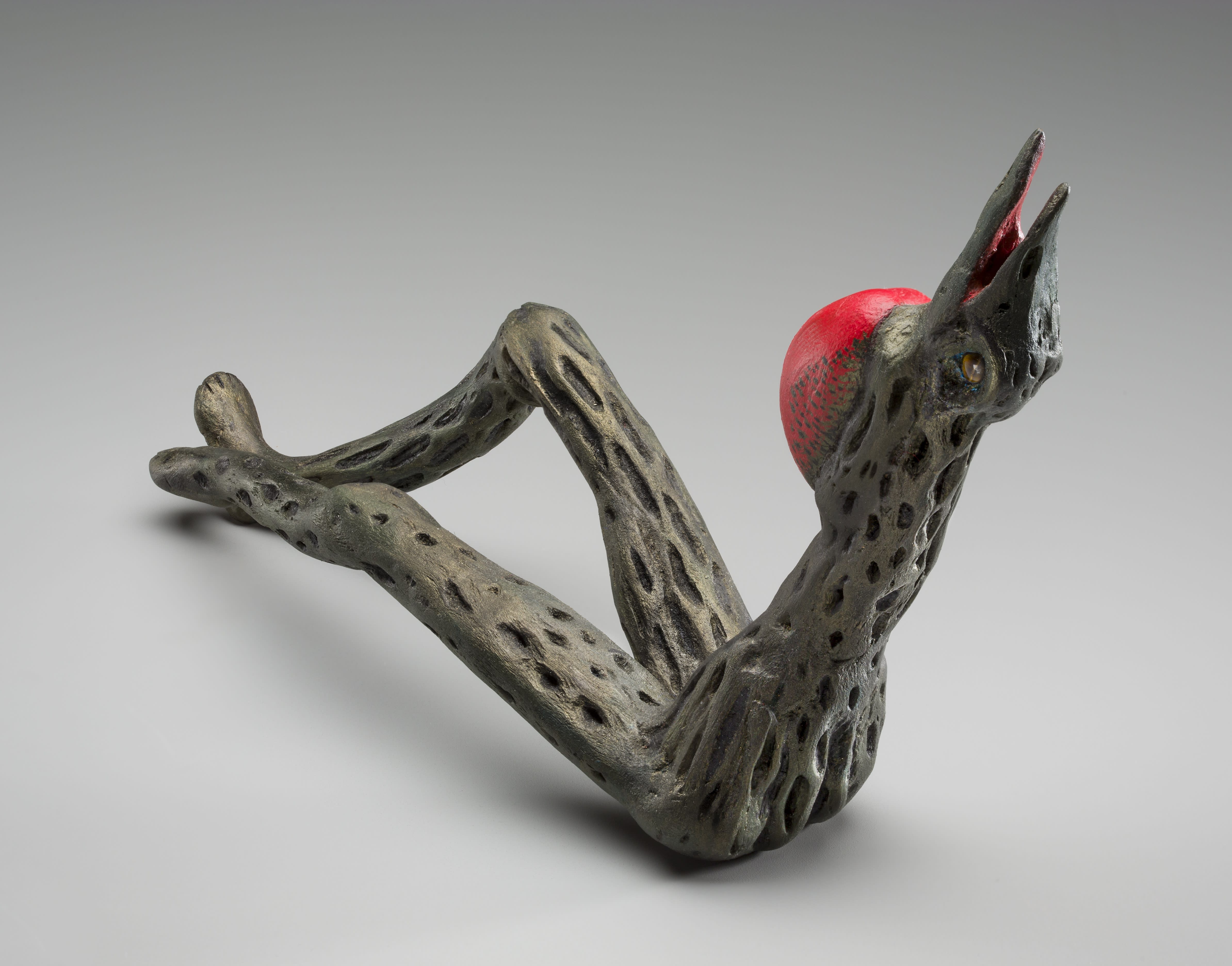
Susan Aaron-Taylor, Endangered, cholla cactus, tiger eye, cabachons.
What’s an example of an artwork inspired by a dream or shamanic journey?
SAT: The piece with the bird head, that came from a shamanic journey that I was doing early in the pandemic. I had started a series about endangered species, so I was working with this endangered bird. It was a Christmas frigatebird from Christmas Island, but the sculpture showed up as a bird head on a human body. I haven’t done figurative stuff for a long time. I was drawing, and this human with a bird head came out. I said, “Ah, humans are endangered too!” I realized that we need to address the fact that we are also endangered.
It seems like there’s so much knowledge stored deep down, if you’re willing to tap into it.
SAT: I think what happens when you journey or when you dream, is your unconscious comes out. I had some clarity. I wasn’t alarmed by this human-bird hybrid, I just said, “Oh, this makes sense.” Nature is just coming up at every turn. When I talk to my friends, because they’re all of like minds, we’ll say, “Well, of course there are going to be earthquakes now.”
Nature is so pissed off, she is angry at us for polluting her and trying to have power over her. Not even believing that there’s global warming, what the hell is that? That’s so upsetting! It’s not just the animal that’s endangered, it’s where they live. Look at the rainforest!
It’s very upsetting, and it’s something that I’ve been working with for a very long time. Is it surprising that we are the next ones? No, it’s not.
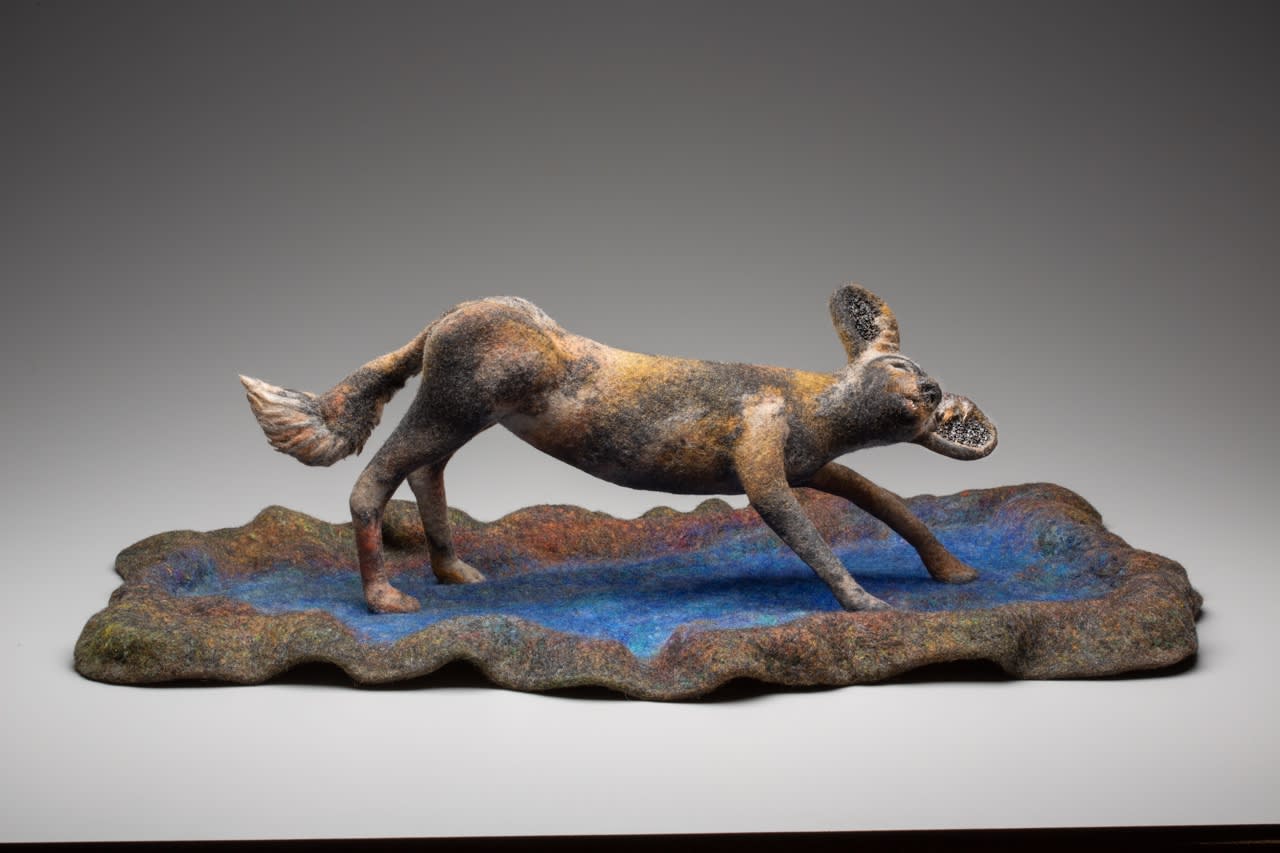
Susan Aaron-Taylor, African Wild Painted Dog, Wood, handmade felt, cabochons, porcupine quills.
Speaking of endangered species, tell me more about African Wild Painted Dog.
SAT: I do a lot of research on which animals are endangered. Then I get a feeling for them, I start relating to them. The painted dog is from Africa, and his loss of habitat is one of the biggest reasons that he’s going away. There are maybe 1,400 left. I really related to the fact that people are encroaching on where he lives. I also liked the fact he’s a pack animal, that these animals work together.
I always do research on how they are in the wild. I go on YouTube and I look at them running in the wild, how they are with their babies. These dogs have the most beautiful coats ever. That’s the other reason that they get killed: people love their coats. They kill them and strip them down. I somehow related to this animal, and I loved putting him in his habitat.
What else has bubbled up for you lately?
SAT: Another piece was from a dream where I discovered a bottle that I was going to give to someone else, but they weren’t going to appreciate it. It was covered with charms, and it was a powerful thing that I needed to work with and keep. At the end of the dream, I ended up in Indonesia walking down a crowded street. I realized no one was social distancing, we were all like sardines. The piece is about salvation. It’s a ritual bottle, it’s about our salvation.
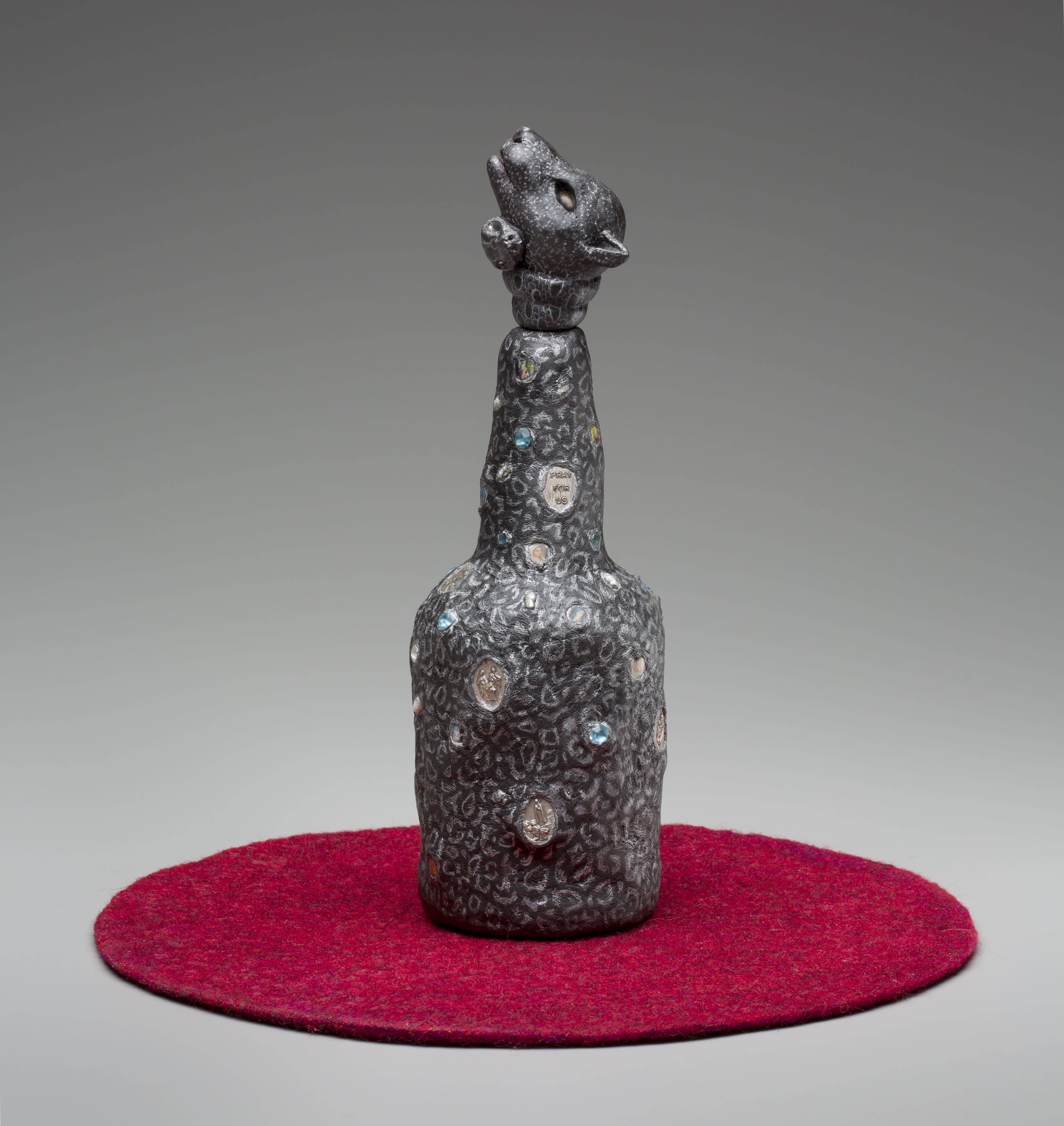
Susan Aaron-Taylor, Salvation, glass bottle, Gampi fiber, religious medals, beads, seeds, handmade felt.
There’s such clear and potent symbolism in that dream! After you’ve dreamed something like that, how do you distill it into an artwork?
SAT: Before I start a piece, I almost always do research on the symbolism. I’m a Jungian, so I’ve been working on dreams and symbols for a long time now, decades. A bottle can be a talisman for protection. But salvation is also associated with sacrifice. It’s the return of the soul after we fall from paradise. That’s exactly where we are. We are totally in the shadow of humankind now. Every darkness that has been pushed under the rug. Now it’s all coming up, and it’s starting to change. It’s transmutation.
I don’t usually drink, but my husband does. I said, “Do you have any bottles?” It turned out that he had a Chivas Regal Whiskey bottle. I filled the bottom of the bottle with things, including seeds you can plant to feed the butterflies, which are transformative symbols. Then I covered it in little medals, one of which says “pray for us.” The stopper is a black panther head, and there’s a snake that winds around it. The snake is an eastern massasauga rattlesnake, the only poisonous snake in Michigan. They’re about transformation, they’re about the whole life cycle.
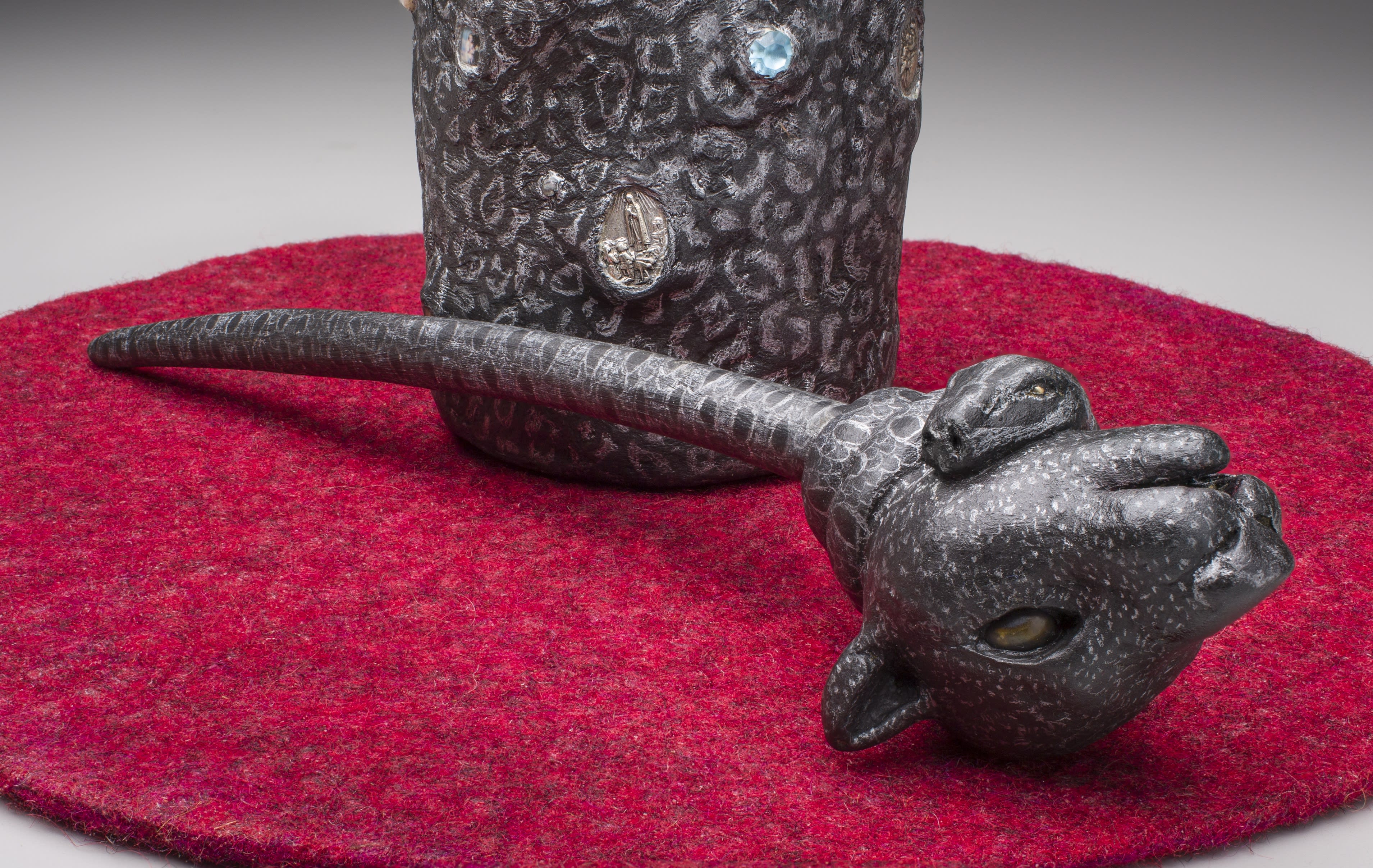
Susan Aaron-Taylor, Salvation (detail), glass bottle, Gampi fiber, religious medals, beads, seeds, handmade felt.
Have you always been particularly attuned to dreams and visions?
SAT: Some people just are dream recallers. Since I was really little, I was a dream recaller. My mother and I would talk about our dreams together when I was little. When I was in my 30’s, I realized that all of this stuff has meaning. I got some books, and I started taking Jungian workshops. Man and His Symbols [by Carl Jung], that was a crucial book to me.
I started taking dream workshops and working with a Jungian analyst. I started waking myself up four or five times a night and writing my dreams down. Then I’d go and teach in the morning. I’d keep a pen and a flashlight by my bed, which wasn’t great for my husband.
I kept dream diaries for years and years and years. Then I had my son and I was sleep-deprived, so then I couldn’t do it as much. Still, when something is really cooking underneath, underground, that dream will come to me and I need to make pieces about them.
In your experience, what is the nature of a dream?
SAT: Dreams come to tell you what you don’t know. They bring up what you suppress during the day. You might dream about taking a test that you haven’t studied for, or having your tooth pulled. Sometimes those are just about something that you couldn’t process during the day. If you do this every single day and write it down, you can tell what you’ve suppressed and what’s important.
Then there’s something in Jung speak, a “big dream.” They’re those dreams where you wake up screaming. These are the ones that I need to make art about. Usually the symbols are universal, they’re not just personal. I’ll try to take a dream that I’ve had and bring them to light, so that someone else can recognize them. People will approach me after seeing my work with their hands on their heart and say, “Oh my god, I’ve felt this way.”

Susan Aaron-Taylor, Black Footed Ferret 1 (detail), cholla cactus, handmade felt, turquoise cabochons.
You’re having these ephemeral experiences and then using pieces of the physical world to reconstruct them in some way. What is your philosophy of materials, and is there an element of alchemy there?
SAT: I think art making is an alchemical process. You’re taking the detritus, things that are cast off, and you’re seeing the beauty in them and then transforming them into a piece. But alchemy was not just about taking lead and turning it into gold. That’s a snappy way of describing it.
The alchemists were philosophers, and they had this whole secret way of communicating. They did it through their paintings and drawings. They were really about commenting on the whole process of becoming a human being. They talk about going into the darkness. It’s a huge part of it. Parts of you have to die, so that’s what we’re doing now.
To make you a more conscious, mindful person, that’s what the philosophers were doing. That’s why Jung did a whole study of alchemy, and it was alchemy in comparison to psychology. They parallel each other through what’s called the individuation process.
I know you also study and draw influence from talismans and other ritual objects. Do you think the world is craving ritual right now?
SAT: I’m hoping. Something is shifting, and I’m hoping that more people will go, “We need a ceremony for this. We need to honor what’s going on.” I think it’s starting to happen, and it’s not necessarily the church. For me, it’s certainly not the church. In general, we need more ceremony and ritual in our lives to be healthy in our own skins. We need to do that.
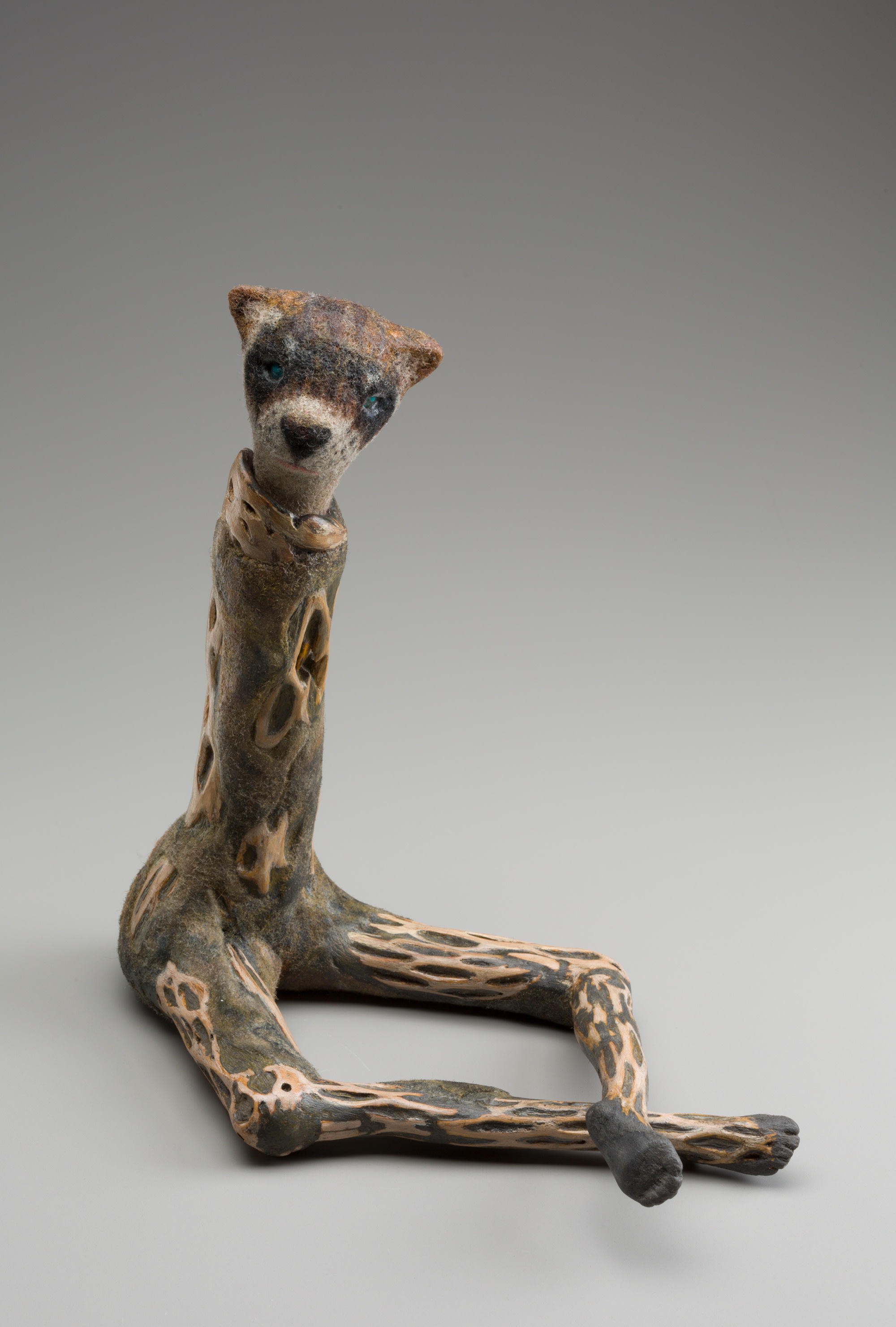
Susan Aaron-Taylor, Black Footed Ferret 1, cholla cactus, handmade felt, turquoise cabochons.
It’s interesting to witness how gallery visitors react to your work. Some people steer clear of it, while others are helplessly drawn to it and even want to pick it up.
SAT: I like the fact that some people will look at a piece that I did and say, “Your work is kind of scary.” And then other people will say, “I want to live with that!” It kind of tells me about them. I like that dichotomy, that there is an edge. It’s not all smiles, people get uncomfortable sometimes.
Speaking of discomfort, what is important about this particular moment in terms of the great transition you were talking about earlier?
SAT: Being at home for these months, where people are getting antsy, that’s good because you need to start looking at your life. You need to start looking at what you believe in. You need to be in silence, and our culture is not about silence.
It’s so difficult to face that sometimes!
SAT: No one wants to look at their shadow, but right now we have to.
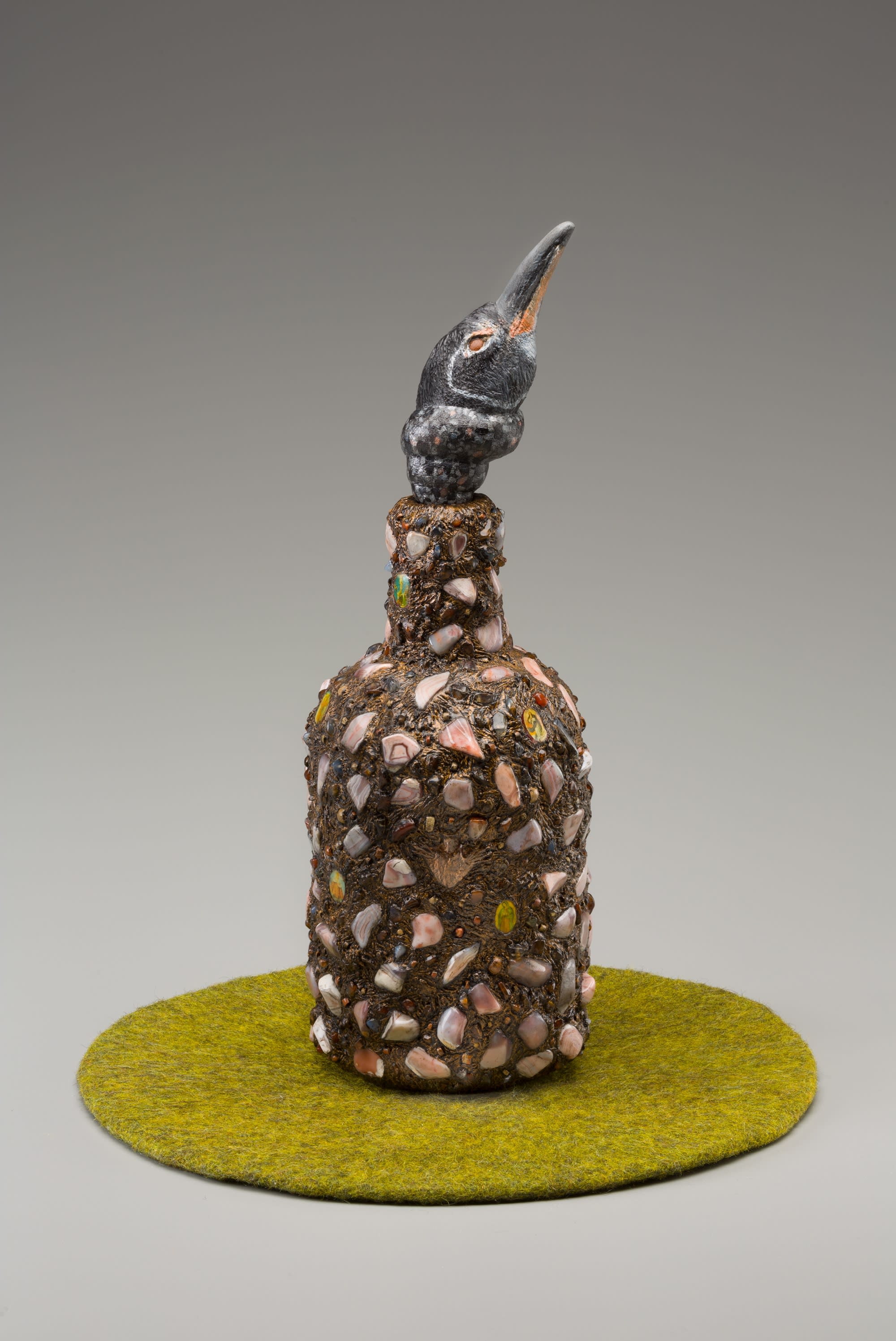
Susan Aaron-Taylor, Grieving Stones, glass bottle, beads, religious medals, Botswana agates.
Comments
Susan has a distinct way of recognizing the unknown and hidden images which bring a deeper consciousness to life. “Scary things” that we may not want to acknowledge but important that we do. I have followed her work for years and await the day when she is given the notoriety for surfacing our buried realities.
Thank you for this fabulous interview of a truly important artist.
What a great interview. I'm obviously prejudiced since I'm Susan's brother. But, between the wonderfully produced artwork and the succinct questions, I was reminded how powerful Susan's work is.